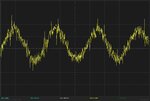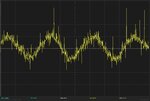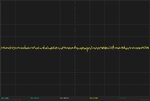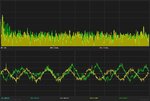weeb0
Junior Member level 2
Hello,
I did not designed analog circuit for long time (I was more on digital and firmware side).
But now, I have to work on a project which require +-1mV sinusoidal (low frequency, 200Hz or less) signal then I have to do some other steps, but the problem is seen at the first stage.
first, I have an oscillator which provide me 2-3V, the signal is not very nice, but I think it is usable. (use the PT78NR105V and PT78ST105V)
I use the following steps :
Oscillator ---> resistor voltage divider ( 10Mohm with 10Kohm ) ---> opamp inverter buffer ( I use 10K as Rinput and 10K as Rfeedback (I have added a Cf of 18pF)
I use the first opamp to isolate the voltage divider.
I can see the signal, but the output is very noisy. The opamp is driven at +-5V. The power noise is near 5mV. The opamp I use is the OPA228 8 soic (no trim). I've seen that the opa228 is not stable on low gain (<5) but tried the LT1197 (edit: LT1097) and I get similar results.
I tried to simulate the circuit with TINA everything is fine.
I know the Zinput is very high, but I never experienced anything like this. I tried to play with the CF, with the resistor value added RC filter ... I can see little change, but not a clean signal as I can see at the input.
I work on a PCB.
I don't know where to look at. I will try with other opamp, which are rated for lower frequency.
Is there anybody that could give me some clues to understand how to work with low voltage signals ?! Should I reduce my power noise ? Is there any paramter I should look?
I'm open to any advice !
Thank you a lot!
I did not designed analog circuit for long time (I was more on digital and firmware side).
But now, I have to work on a project which require +-1mV sinusoidal (low frequency, 200Hz or less) signal then I have to do some other steps, but the problem is seen at the first stage.
first, I have an oscillator which provide me 2-3V, the signal is not very nice, but I think it is usable. (use the PT78NR105V and PT78ST105V)
I use the following steps :
Oscillator ---> resistor voltage divider ( 10Mohm with 10Kohm ) ---> opamp inverter buffer ( I use 10K as Rinput and 10K as Rfeedback (I have added a Cf of 18pF)
I use the first opamp to isolate the voltage divider.
I can see the signal, but the output is very noisy. The opamp is driven at +-5V. The power noise is near 5mV. The opamp I use is the OPA228 8 soic (no trim). I've seen that the opa228 is not stable on low gain (<5) but tried the LT1197 (edit: LT1097) and I get similar results.
I tried to simulate the circuit with TINA everything is fine.
I know the Zinput is very high, but I never experienced anything like this. I tried to play with the CF, with the resistor value added RC filter ... I can see little change, but not a clean signal as I can see at the input.
I work on a PCB.
I don't know where to look at. I will try with other opamp, which are rated for lower frequency.
Is there anybody that could give me some clues to understand how to work with low voltage signals ?! Should I reduce my power noise ? Is there any paramter I should look?
I'm open to any advice !
Thank you a lot!
Last edited:







